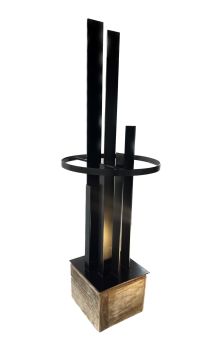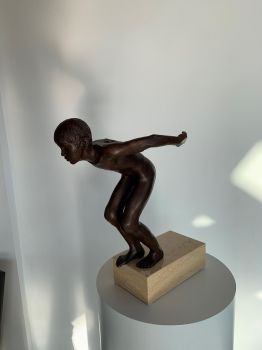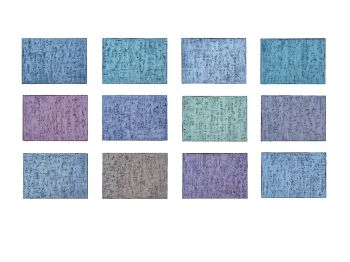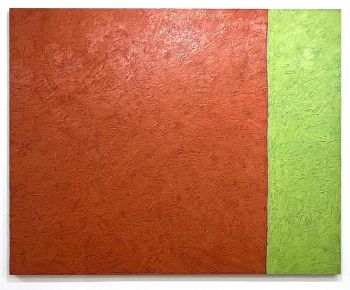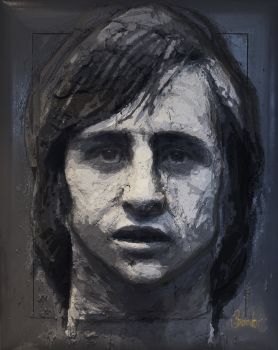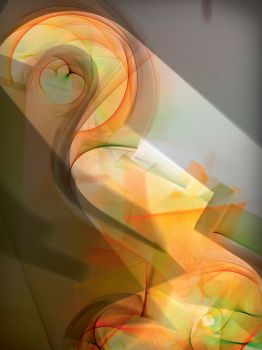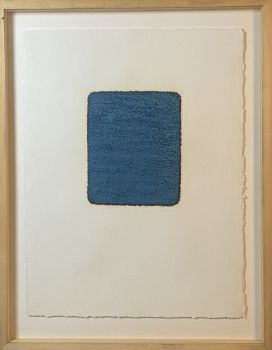Troug- Cadmium Yellow Deep 2003
JOHANNES GIRARDONI
HoutWaxBijenwas
254 ⨯ 28 ⨯ 55 cm
ConditionNeeds restoration
€ 5.000
Gallerease Selected
- Over kunstwerkExhibited in Museum Ludwig 2005
Part of Series 2003–2011, Beeswax, pigment, wood
Light Reactive Organic Sculptures comprise an extensive body of work that has evolved over the past two decades. The work focuses on reductive investigations at the intersection of sculpture and painting, and explores the continuously shifting relationship between light and material. Despite an elemental material vocabulary — found wood, beeswax, and pigment — the work’s physical constellation becomes both the carrier of an explicitly painterly event, while also being the foundation of an immaterial phenomenon. The pieces are often examinations of phenomenological processes, where a hollow or empty space — a tangible emptiness — turns out to be the actual center of the work. Opposites and contradictions, as well as the complex dialectic between them, are the fundamental themes. The orchestration of material and light, presence and absence, things found and things formed, all resist clear fixation, thereby maintaining and creating works with their own non-derivable reality.
The primary material organization is found wood that forms the base for color built with pigment and beeswax. The wood is harvested from urban debris at building constructions and deconstructions, and in its worn and deteriorated condition, creates an instant history. These structures become the foundation for an architecture of color in which the material is color, and the color is material. Built by suspending varying degrees of pigment in layer over thin layer of beeswax, light travels into the wax and encircles the pigment. This results in light reactivity, and juxtaposed to the static, aged structure of the wood, the sculptures’ pigmented wax evolves and adapts to changing ambient light situations. These sculptures hold light.
"Girardoni’s use of wax, influenced by Jasper John’s paintings with encaustic — such as Flag and Target — and related to Brice Marden’s use of the material in his opaque, monochrome pictures from the 1960s, ultimately led the artist to sculptural procedures: “Wax catalyzed the move away from ‘painting’ … The beeswax allowed me to ‘build’ color.” Girardoni prefers using wooden slats, boards, or parts of wooden beams as construction material, where traces of their use have been recorded. To this the artist applies the material color — pigmented wax. Through their ready-made character the artist instills a uniqueness and reference to life in the objects. At first glance, the works, which are oriented towards geometric forms and series, seem like minimalist art in the succession of Carl Andre, Sol LeWit and Donald Judd. The major difference in Girardoni’s works, however, is that they have an organic and human atmosphere, while the cubes, fences and plates, due to their industrial production, emanate coolness. (…) Even though Girardoni leaves both the inner and outer panels abstract, he is nevertheless concerned with a contemplative experience, and not solely with a matter-of- fact inventory of color, material, and structure. Joseph Beuys had attributed beeswax a symbolic-spiritual function, that of warmth and energy. These may also be experienced in Girardoni’s objects, paired with painterly, coloristic, and tactile qualities".
– Florian Steininger - Over kunstenaar
Johannes Girardoni, een Oostenrijks-Amerikaanse kunstenaar geboren in 1967, staat bekend om zijn boeiende samensmelting van digitale en analoge media en heeft een onuitwisbare stempel gedrukt op het gebied van beeldhouwkunst en installatiekunst. Van ingewikkelde, delicate creaties tot uitgestrekte, interactieve lichtwonderen: het artistieke repertoire van Girardoni omvat een adembenemend spectrum.
Girardoni groeide op in een pittoresk dorpje in de buurt van Wenen en doorkruiste de continenten toen hij in 1982 op veertienjarige leeftijd met zijn gezin naar Californië verhuisde. Zijn vormingsjaren aan het Bowdoin College in Maine van 1985 tot 1989, waar hij zowel geschiedenis als kunst studeerde, legden de basis voor zijn artistieke odyssee. Tijdens zijn ambtstermijn bij Bowdoin verscherpte Girardoni zijn vak als gastkunstenaar bij het gerenommeerde MIT Media Lab.
Girardoni's artistieke ontwikkeling van tweedimensionale naar driedimensionale expressie weerspiegelt zijn voorkeur voor experiment. Beïnvloed door de hot wax-schildertechnieken van grootheden als Brice Marden en Jasper Johns, belichaamt zijn werk een boeiend samenspel van formele contrasten.
De wereld werd zich bewust van Girardoni's vindingrijkheid toen hij in 1991 zijn eerste tentoonstelling in New York presenteerde, voortgestuwd door het scherpzinnige oog van kunstconservator Friedhelm Mennekes. In de loop der jaren breidde Girardoni's artistieke voetafdruk zich wereldwijd uit, met opmerkelijke tentoonstellingen zoals de tentoonstelling "Personal Structures" in het Ludwig Museum, Duitsland, in 2005 en deelname aan de tentoonstelling "Origins", georganiseerd door het Hudson Valley Center for Contemporary Art in Peekskill, New York, werd gesponsord.
Een van Girardoni's baanbrekende bijdragen is het concept van "Refrequenced Sculpture", dat tot uiting komt in zijn installatie "7 Minutes 20 Seconds" uit 2009 in de tentoonstelling "Creative Migration" op het Austrian Cultural Forum in New York. Zijn belangrijkste werk ‘The (Dis)appearance of Everything’, gepresenteerd op de 54e Biënnale van Venetië in 2011, combineert licht en geluid naadloos om een meeslepende, interactieve ervaring te creëren.
In 2013 presenteerde Girardoni een fascinerende presentatie getiteld "Off and On" bij Nye & Brown in Los Angeles, Californië, met avant-gardistische installaties die licht en geluid transformeren met behulp van de allernieuwste technologie. In het bijzonder bevatte zijn onderzoekstentoonstelling uit 2018 in Levy Gorvy Londen, getiteld "Sensing Singularity", de baanbrekende installatie "Metaspace V3", een bewijs van Girardoni's pioniersgeest bij het integreren van softwaregestuurde elementen in menselijke interactie.
Tot zijn opmerkelijke werken behoren 'The Infinite Room', een monumentaal beeldhouwwerk in de staat Washington, en 'Spectral Bridge', een architectonisch wonder dat het Spectral Bridge House in Venetië, Californië siert, als bewijs van Girardoni's artistieke bekwaamheid. Een boekdeel met de titel Johannes Girardoni, gepubliceerd in 2007, biedt een uitgebreid overzicht van zijn artistieke reis, terwijl de opname ervan in de prestigieuze collecties van instellingen zoals het Fogg Museum aan de Harvard Universiteit en het Museum Ludwig in Keulen, Duitsland, zijn blijvende nalatenschap onderstreept.
De uitmuntende bijdragen van Girardoni hebben erkenning gekregen, met als hoogtepunt prijzen zoals de prestigieuze Francis J. Greenburger Award in 2019. Zowel critici als kenners hebben Girardoni's werk geprezen om zijn indrukwekkende weerklank en innovatieve samensmelting van media. Van de weelderige landschappen van Hongarije tot de drukke straten van New York, Girardoni's kunst overstijgt grenzen en nodigt de kijker uit op een transcendente reis van verkenning en introspectie.
Bent u geïnteresseerd om dit kunstwerk te kopen?
Artwork details
Related artworks
- 1 - 4 / 24
Rene Rietmeyer
“NETHERLANDS BRABANT NOVEMBER 2000”2000
Prijs op aanvraagEuropean Cultural Centre Collection
Rene Rietmeyer
"USA South Florida January 2006"2006
Prijs op aanvraagEuropean Cultural Centre Collection
Jean-François Rauzier
Yali Veduta - Limited edition of 8 (Hyperphotography light box)2015 - 2024
Prijs op aanvraagVilla del Arte Galleries
Samuel Dejong
Anatomia Blue Heritage, Atlas Closed2017 - 2019
Prijs op aanvraagVilla del Arte Galleries
1 - 4 / 24Onbekende Kunstenaar
A Surinam-themed Amsterdam long-case clock1746 - 1756
Prijs op aanvraagZebregs & Röell - Fine Art - Antiques
 Gecureerd door
Gecureerd doorGallerease Magazine
1 - 4 / 24- 1 - 4 / 12








